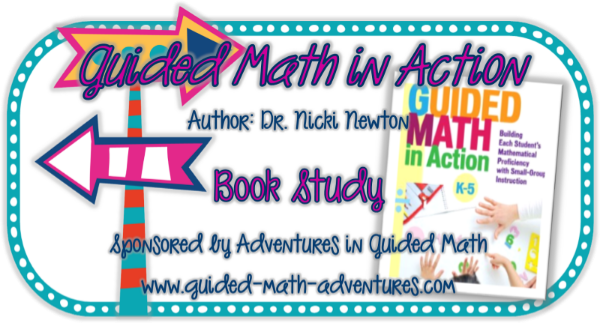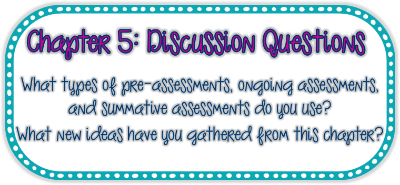
Our book study continues with Chapter 5: "Balanced Assessment - The Key to Grouping Students." This chapter was all about using different assessment to help group students for small group instruction. Dr. Newton discusses ways for pre-assessment, ongoing (or formative) assessment, and evaluative (or summative) assessment. This chapter was chock full of practical ideas, but there were some things that I was left wondering about. More on that in just a bit.
Now, on to the questions.

Question 1 - The way our math framework is set up at my school, we do a "pre-assessment" every day. In third grade, we call it the problem of the day. This consists of 3 questions. The first question is a question from the previous day's lesson. It helps us to determine who is still understanding the material from the day before. The second question covers the new material we are learning that day. The final question is of a cyclical nature and can be from any topic we have covered up to the point, usually place value, multiplication, or fractions. These questions help us to determine who will be working with us in which groups that day. This is a bit different from the way Dr. Newton describes her pre-assessment. I love many of the ideas that she shared, but the sad reality (at least in my context) is that I often cannot fit all of those pieces in.
For on-going assessments, I use many of the centers activities that the students complete, as well as the first section of the problem of the day. I also give several written quizzes throughout the unit. These activities are designed to help me understand how the students are progressing. Our county recently began adopting a collection of questions (for lack of a better term) that are collected online. This allows us to create quizzes and tests that can be taken online. However, adoption of this practice has been slow. I guess old habits (written tests) die hard.
The summative assessments tend to be your typical paper and pencil tests.
Throughout the year, usually three times, our entire school gives a test that helps us to determine where a student is according to a benchmark score. It is the same test each time and the students are expected to make growth on the test throughout the year. This test is not without weakness, but it does allow me to determine what students may be falling behind in particular areas. The two main weaknesses are that the test includes questions that are not covered by our learning standards and the test is timed. Some students just don't test well when under time pressure.
Question 2 - There were a number of great ideas in this chapter. First, I am going to have to find some time to make versions of the interview forms Dr. Newton has in the book. I am reading my copy of the book on my iPad, so the formatting is a bit different.
Second, I need to find out what Math Running Records are. If you know, can you please leave a comment and direct me to the right place.
Finally, I am interested in putting together student portfolios. I will be working with special education students next year and this data will be necessary for IEP meetings. As I mentioned before, Evernote will be perfect for working on this. There is a feature on the app that allows Post-It notes to be photographed and cataloged. Perfect for anecdotal records and portfolios.
This brings us to the end of another chapter. If you haven't heard, there is a Q&A with Dr. Newton happening at Guided Math Adventures. Head over there for all the details. Thanks for participating.

That is a neat pre-assessment piece. That is bound to give you some valuable information, not only did they learn what you taught the day before (at least a piece of it), but do they know anything about what you are getting ready to teach, and how about that review.
ReplyDeleteGood question about running records in math. The only thing I can relate it to would be math facts - like in her opening of the chapter. But, I am not sure. I hope someone can answer that for us. Maybe that is a good question for Dr. Nicki's Q & A.